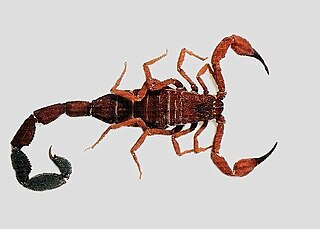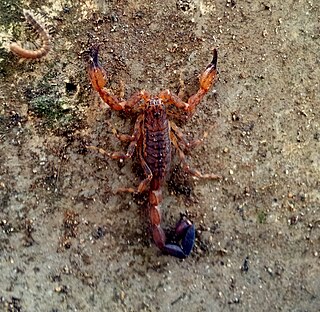
Pulmonoscorpius is an extinct genus of scorpion from the Mississippian of Scotland. It contains a single named species, Pulmonoscorpius kirktonensis. It was one of the largest scorpions to have ever lived, with the largest known individual having an estimated length exceeding 70 cm. Pulmonoscorpius retains several general arthropod features which are absent in modern scorpions, such as large lateral eyes and a lack of adaptations for a burrowing lifestyle. It was likely an active diurnal predator, and the presence of book lungs indicate that it was fully terrestrial.

The Buthidae are the largest family of scorpions, containing about 100 genera and 1339 species as of 2022. A few very large genera are known, but a high number of species-poor or monotypic ones also exist. New taxa are being described at a rate of several new species per year. They have a cosmopolitan distribution throughout tropical and subtropical environments worldwide. Together with four other families, the Buthidae make up the superfamily Buthoidea. The family was established by Carl Ludwig Koch in 1837.

Tityus is a large genus of thick-tailed scorpions, the namesake of its subfamily Tityinae. As of 2021, Tityus contains more than 220 described species distributed in Central America and South America, from Costa Rica to Argentina. Species in the genus Tityus have been studied for hundreds of years, long before the taxonomic classification was put in place. Tityus tend to be of medium size for scorpions, roughly 50 to 70 millimeters long. They are dark brown or red in color, and can exhibit sexual dimorphism. They can live in a variety of environments, ranging from urban to arid mountains to the Amazon Rainforest. Tityus scorpions are best known for their venom and potent sting. The genus contains several dangerously venomous scorpions, the best known of which is the Brazilian yellow scorpion, T. serrulatus. Its venom can cause severe illness, and in the young, old and infirm even death. Some experts have argued that the genus as a whole may be paraphyletic, which could explain the knowledge gaps related to Tityus.

Uroplectes is a genus of scorpions in the family Buthidae. They are known commonly as the lesser thick-tailed scorpions. There are about 40 species distributed in the Afrotropical realm. They are most diverse in South Africa.

Chaerilus is a genus of scorpions in the family Chaerilidae. They live in tropical parts of South Asia and Southeast Asia. A fossil genus Electrochaerilus is known from the Late Cretaceous (Cenomanian) aged Burmese amber.

Isometrus maculatus, commonly as the lesser brown scorpion, is a species of scorpion in the family Buthidae. Its distribution is pantropical; it is an introduced species in Hawaii.
Reddyanus basilicus is a species of scorpion in the family Buthidae.

Reddyanus besucheti is a species of scorpion in the family Buthidae endemic to Sri Lanka.
Reddyanus problematicus, previously known as Isometrus problematicus, is a species of scorpion in the family Buthidae. Found in India, the species exhibits distinct characteristics. In females, the total body length measures approximately 22 millimeters (mm). The pedipalps, legs, and segments of the metasoma display a coloration ranging from yellow to reddish-brown, accentuated by black spots.
Reddyanus loebli is a species of scorpion in the family Buthidae.

Tityus apozonalli is an extinct species of scorpion in the family Buthidae known from a fossil found in North America. The species is one of two scorpions described from Mexican amber and one of seven species from Central American amber deposits.

Hottentotta conspersus, the Sesriem scorpion, is a species of scorpion of the family Buthidae.
Tityus asthenes is a significantly venomous scorpion endemic to South America. Sometimes it is known as Peruvian black scorpion.

Charmus is a genus of buthid scorpions native to India and Sri Lanka.

Reddyanus is a genus of buthid scorpions native to Oriental region from India, Sri Lanka, China: Tibet, to Melanesia. The genus was previously described as a subgenus of Isometrus.
Reddyanus ceylonensis is a species of scorpion in the family Buthidae endemic to Sri Lanka.
Reddyanus jayarathnei is a species of scorpion in the family Buthidae endemic to Sri Lanka.
Reddyanus ranawanai is a species of scorpion in the family Buthidae endemic to Sri Lanka.
Heterometrus serratus is a species of scorpion in the family Buthidae endemic to Sri Lanka where it is restricted to southern parts.
Mesobuthus zarudnyi, a scorpion species within the Buthidae family, was formally documented in Azerbaijan in 2022, its discovery was attributed to the region of the Absheron peninsula. This species is named in honor of Nikolai Zarudny (1859–1919), a distinguished Russian zoologist and explorer renowned for his extensive collection of scorpion specimens in Persia from 1896 to 1904, which greatly contributed to the field of zoology.











